Here’s a quick riddle for you: what takes 20 years to build, and five minutes to ruin? Arguably, many things. But, as Warren Buffet famously stated, brand reputation is certainly one of the first that comes to mind.
As fragile and intangible as it is, brand reputation is one of the most important assets of a company. The State of Corporate reputation reports that 63% of a company’s market value is directly related to its reputation, while 87% of executives consider reputational challenges more important than other strategic risks.
In this blog, we decided to bring you all you need to know about brand reputation. Read on to learn more about everything from monitoring and analysis to brand reputation management tools and expert tips!
What is Brand Reputation?
Simply put, brand reputation is the public’s perception of a company or an organization.
How the public views a certain brand is based on their personal direct or indirect experience with the brand. It encompasses everything from the quality of a brand’s products or services to how they treat their customers and employees.
Hence, managing brand reputation involves:
- Publicly addressing criticism,
- Being open to feedback,
- Allowing all stakeholders to share their experiences,
- Engaging with your audience.
As per reputation management expert Paul Blanchard’s Forbes article, brand reputation is also the nexus of influences consumers are affected by when making a conscious or unconscious choice between brands.
Why is Brand Reputation Important?
The thing is, every brand conveys a message. Be it a certain philosophy, lifestyle, and even a social or political stance. Likewise, owning a certain product also means that a consumer often associates themselves with the brand’s reputation.
Take Apple, for instance.
Their products enjoy the reputation of being reliable, efficient, and very stylish. Up to an extent, they have even become a status symbol. Thus, someone looking for a new mobile phone might opt for an iPhone for its connotations, rather than for its technological aspect.
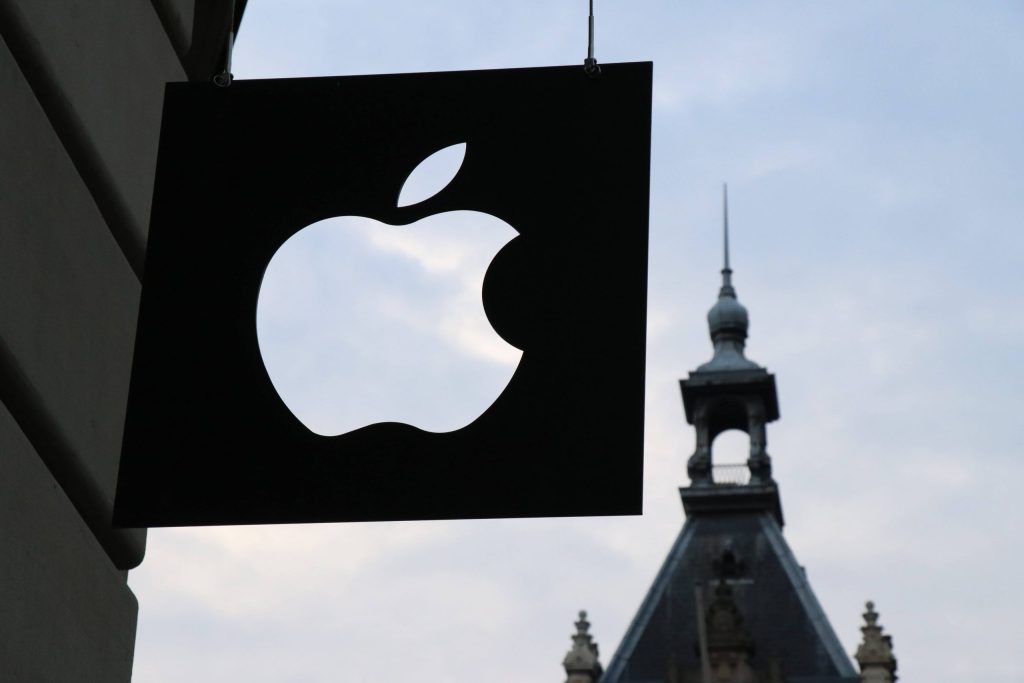
On the other hand, brand reputation can sometimes backfire. A great example of this is Gillette.
Going from promoting a manly man philosophy to changing settled behavior patterns that could cause unacceptable social behavior didn’t sit right with many and even led to a boycott of the brand.
These are, of course, high-scale examples. But, brand reputation is equally, if not more important when it comes to smaller brands since they depend on it. And so, to answer the question of why is brand reputation important, the most important takeaway here is that it can truly make or break a brand.
Read Gillette – the New Example of Marketing of Values
The deciding factor that shapes brand reputation
So, what is the deciding factor in whether a brand is deemed trustworthy or unfavorable?
Before the last decade or so, public relations and advertising shaped brand reputation. But, as research suggests, 84% of Millennials don’t trust traditional advertising anymore. Instead, they rely on thoughts and experiences shared by their peers online.
Due to this fact and the rise of social media, consumers have the greatest say in how a brand is perceived nowadays. Online discussions, reviews, posts, and articles about a brand can make it or break it.
Read: How Dove’s reputation crisis unraveled on social media
Ink. reports 91% of consumers do brand research regularly or occasionally, while 68% form their opinion after reading between one and six online reviews.
That’s why you need to ensure unchecked negative reviews are not what steers their purchasing decisions. Not only does one indicate a bad customer experience, but it also shows a lack of a brand’s willingness to resolve the issue.
Both of these are not something you want a potential customer to see when researching your brand, products, or services.
Dima Suponau, the CEO of Number For Live Person, further explains:
“One thing I always tell my employees is that our brand is reflected in every single thing we do and that our customers always have other options. We never kid ourselves that we’re the only game in town and, so, reputation management is vital to ensure that our customers aren’t going elsewhere.“
Benefits of Brand Reputation Management
If you did your digital PR right, you could rest assured that your brand will instill both trust and loyalty into your (potential) customers.
Marketing91 notes that brand reputation can also:
- Ensure higher sales by establishing long-term relationships with its customers and consistently maintaining the quality and service levels,
- Provide a competitive edge by becoming familiar and well-known amongst customers’ friends and family as a go-to brand,
- Turn customers into brand ambassadors by making them inclined to share positive experiences and word of mouth recommendations,
- Impact business expansion by giving the management confidence to tap into new markets and expand the operations of the company or its product line and offerings,
- Retain employees by becoming a desirable employer that enjoys a good repute in the market and that people will want to associate themselves with professionally.
As you can see, brand reputation provides a significant competitive advantage when positive. It can also harm consumer trust, lead generation, and sales if negative. Hence, managing it should not only be a necessity, but rather a priority.
Behind every great brand, there is brand reputation monitoring
The first step to making your brand a consumer favorite is to track its online presence, that is, to monitor your brand reputation and other relevant information that might impact your brand. Only then can you measure the true impact that online mentions have on your brand reputation and transform those inputs into actionable steps.
Now, remember how we established that consumers love to share their thoughts and opinions online? Well, the key thing to keep in mind here is that 96% of online conversations about a brand happens outside official brand channels.

For brands that don’t take a wholesome approach to brand reputation monitoring, that means they will predominantly not even be aware of their actual brand reputation if they’re not tagged.
Brand reputation monitoring enables brands to be notified of every single brand mention, no matter the source. Then, they can react to it either by simply acknowledging the mention or engaging with its author.
Moreover, having such an overview will make it easier for you to prevent or manage crises that arise due to ever-changing trends and consumer preferences, habits, and expectations.
Simply, knowing about a potentially vulnerable mention as soon as it emerges will give you more time to manage it. Then, you can come up with an appropriate response, rather than resolving the issue once it’s on a much larger scale.
Read: The 8 steps to creating a crisis communications plan
Brand Reputation Monitoring To-do’s
That being said, here are some tips on brand reputation monitoring:
#1 Automate your brand reputation monitoring
By now, you’ve hopefully realized manual brand monitoring is not the way to go. Not only is it time-consuming, but it also doesn’t result in relevant data needed to conduct an effective brand reputation analysis.
The good news is, that there are brand monitoring tools that will automate the process of brand reputation monitoring.
By crawling mentions in real-time and in any language across 100+ million online sources, they will ensure that you see the bigger picture and unlock the full potential of your brand. Moreover, you’ll get invaluable brand and audience insights you can use to guide your brand reputation in a positive direction. We’ll demonstrate this a bit later in the brand reputation analysis section.
#2 Don’t overlook any of the sources
When doing your research, you should not overlook outlets beyond your social media channels and SERP results, because your customers surely don’t.
There is a wide variety of platforms people use to learn more about a brand. In addition to social media, those also include many websites, blogs, forums, and even comments. All of those pave the way for your customers’ journey with the brand.
Read Reputation Research: Importance, Benefits and Tools

Hence, you need to always make sure you’re getting information from every relevant source. Addressing both positive and negative consumer feedback across all sources will attract potential customers to your brand. It shows that you intend to provide everyone with the best customer experience.
Furthermore, monitoring all sources your brand is mentioned on will prevent a discrepancy from happening on the sources you successfully manage and those that you leave unchecked. This is often the reason for consumer’s suspicion in the validity of the reviews on your owned media.
#3 Monitor more than just your brand name
Just as importantly, make sure to take into account a wide range of aspects that affect brand reputation beyond monitoring your brand name only. Those are:
- Company or brand name and common misspellings
- Products and services
- Key people
- PR and Marketing efforts (press releases, campaigns, hashtags, etc.)
- Competitors
- Industry news, trends, and buzzwords
- Other stakeholders.
Brands oftentimes ignore the role that some of these factors play in their brand reputation. We mentioned the case of Gillette, where a marketing campaign had a major effect on the brand’s public perception. In other cases, the CEO might tweet something reckless and start a crisis.
Tracking these queries will provide you with a bigger picture of how your brand is performing in the eyes of the public. That way, you can establish your strengths and weaknesses, as well as identify threats and opportunities.
#4 Implement social listening
A great way to deepen the insights into your brand reputation is to implement social listening.
In case you’re unfamiliar with it, social listening is the activity of identifying potential growth opportunities and then reacting accordingly based on insights obtained through media monitoring.
It relies on monitoring online conversations about topics of interest. But, rather than just simply collecting information, social listening enables you to learn the meaning behind the data as well. So, in addition to knowing who said what, when, where, in what context, and with what impact, it also provides the why. That way, you can be proactive and recognize trends and patterns.
#5 Use real-time alerts
In addition to monitoring your brand reputation, you should also consider using a tool which provides the option of real-time alerts. As a result, anytime your brand is mentioned online, you’ll know instantly what was said and the impact that might have on your brand. These are called Smart Alerts in Determ.
In the case of a positive brand mention, you have the opportunity to promptly take advantage of the customers’ enthusiasm by engaging with them or resharing the user-generated content. On the other hand, if any misinformation about your brand appears or a competitor makes a move that might harm your reputation, you’ll be informed of it straight away.
There is also an option of setting up Spike Alerts in Determ. These are notifications that you get whenever there is an increase in the number of mentions over a certain period of time and from a certain topic. This can be a great signal of virality and an occurrence you might want to take a look at.
Knowing of something the moment it happens is priceless. It gives you the means to respond to any situation in the right manner and alleviate its consequences.
As Monarch Air Group‘s Director of PR and Marketing Alina Gavrushenko shares:
“Being current with the news allows professionals to plan ahead. Most PR professionals thrive in a crisis because they are prepared to handle a number of situations. For instance, we were successfully able to support our clients during Covid because we knew we had to get ahead of the problem. As a result, we not only helped transport “high-risk” clients but we partnered with SPCA to reunite 47 dogs and cats with veterans as borders were shutting down.
Read: Alerts & digests: how to keep up with your mentions
How to Conduct a Brand Reputation Analysis
Now that you’ve got brand reputation monitoring figured out, it’s time to reap the benefits. By conducting a brand reputation analysis, you can identify what works and what does not. Then, you can optimize your brand strategy accordingly.
The first step is to head over to the reports section of a media monitoring tool of your choice. We’ll be using Determ to show you some of the most important metrics here.
Brand reputation metrics
Mentions over time
The Mentions over time graph shows how your brand mentions performed over the selected period.
The number of mentions might be relatively constant or fluctuate. In the latter case, you’ll probably see a lot of peaks and drops. Clicking on them will open a new window showing all the mentions from that day. That enables you to identify what caused such an increase or decrease in mentions.
Sources
The Sources chart shows the mentions your brand is mentioned on, as well as the share of each source. It is one of the most useful brand reputation metrics.
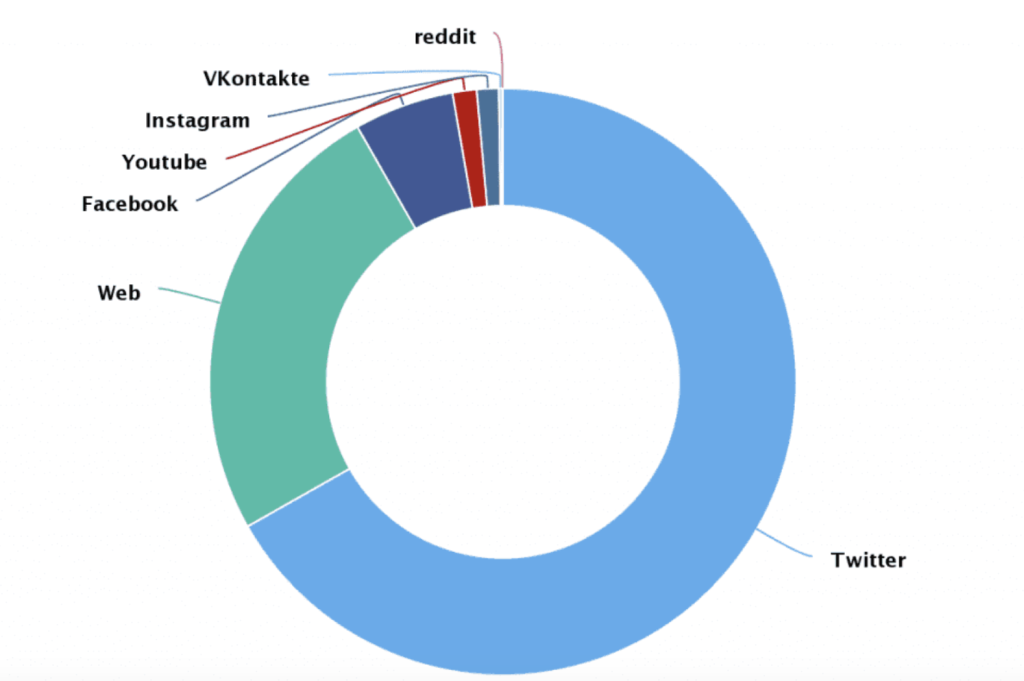
The great thing about it is that it will enable you to identify which channels your target audience uses to talk about your query.
Since you have this information at your disposal, you can create a strategy that focuses on those channels the most. That way, you eliminate second-guessing or spending your budget testing various channels.
Sentiment analysis
The sentiment analysis might be one of the most important brand reputation metrics, especially when it comes to brand reputation analysis.
If you’re focusing solely on the numbers, you might fall into a trap. The high number of mentions does not mean your brand is doing great. That’s because, in reality, the vast majority of those mentions could be terrible reviews.
Sentiment analysis provides context for your mentions and helps you understand your data. It shows you the general attitude towards your brand or any of the topics you monitor alongside. The sentiment is defined as positive, negative, or neutral.
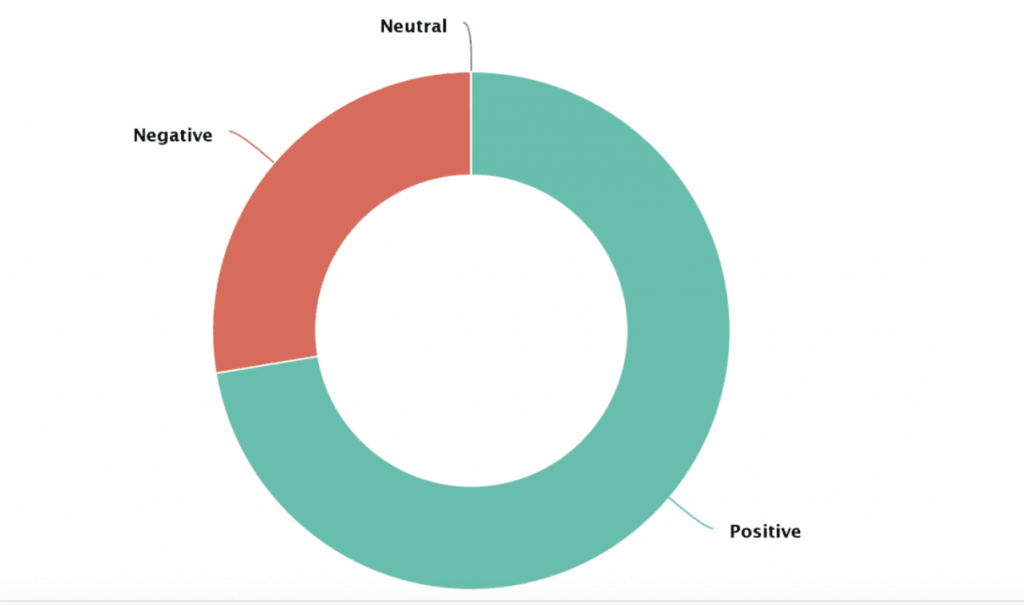
You could go deeper into the data by analyzing the sentiment across several sources. That way, you could learn whether some channels have a greater impact on your brand reputation and identify the reason behind it.
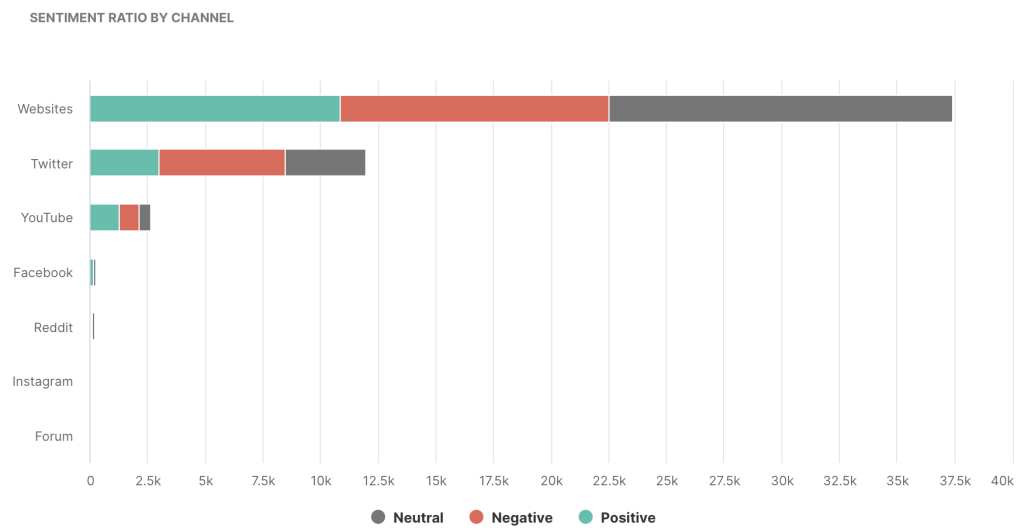
The Sentiment ratio over time is a great indicator of how your brand reputation stands over some time. In times of crisis, you’ll probably see the negative peaks more than the positive. When you’re in the clear, you should mostly see neutral or positive sentiment prevailing.
Read: All you need to know about brand sentiment analysis
The Influencer dashboard
It’s no surprise that influencers have a major impact on brand reputation. They have become a marketing powerhouse that’s hard, if not impossible to ignore.
For that reason, when conducting your brand reputation analysis, you should always take into account what the most relevant influencers are posting.
As you track your query, Determ will automatically list the top 10 influencers. They will be sorted by the number of mentions, source, reach, and sentiment. These are usually the most influential users, media, or accounts posting about a certain topic.
Clicking on any of the usernames will list out their posts containing your query. That way, you can further inspect the influencer’s content.
Then, evaluate if it is something that is or could be beneficial to your brand reputation. Likewise, if their posts are negative, you could look into it and see how it can be improved.
Competitive analysis
Competitive analysis is used when you want to compare two or more queries. It enables you to benchmark and gain competitive insight. That way, you can learn all about the strengths and weaknesses of a brand, product, market, and many more.
One of the charts found in Determ’s Competitive analysis is the Share of voice. It acts as a measure of reach. As such, it shows the share of exposure for selected queries and is an invaluable brand reputation metric.
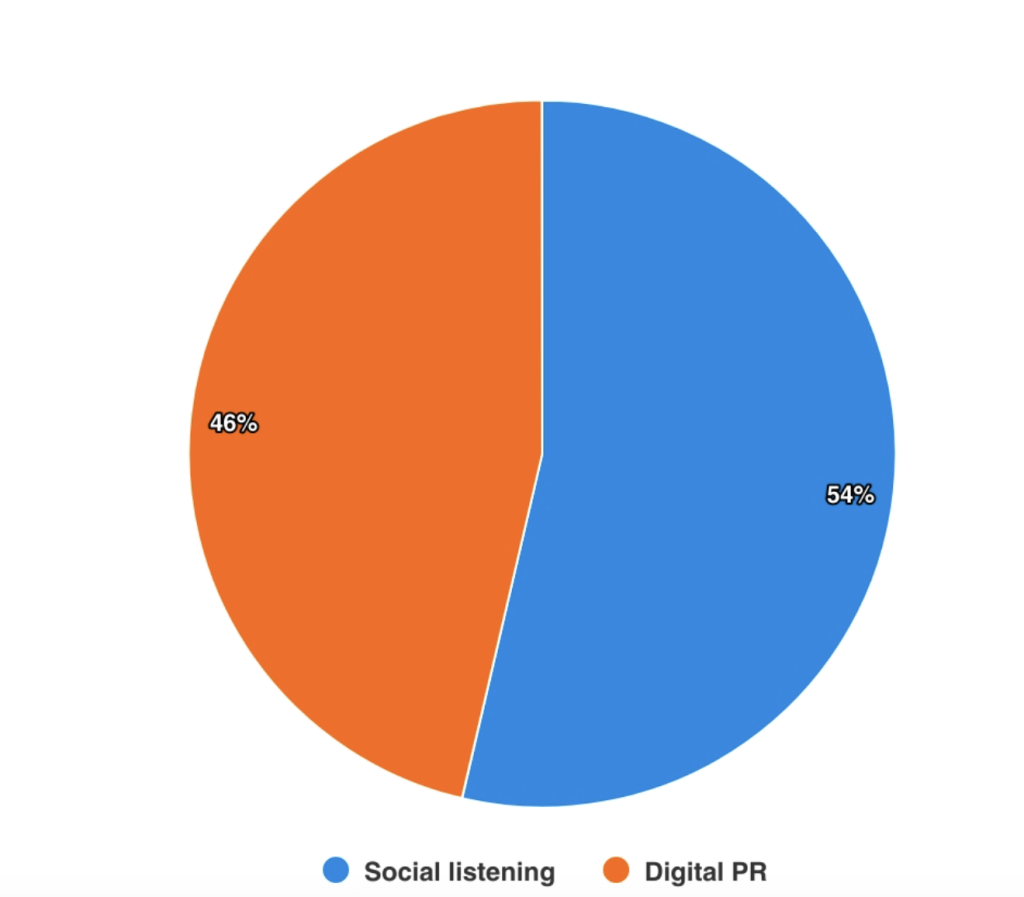
Next, you could use the Mentions by channels to compare how you stand against your competitors on various channels. If your competitor has a much greater number of mentions on a certain channel, it might indicate you should inspect what are they doing great and improve your efforts on that source.
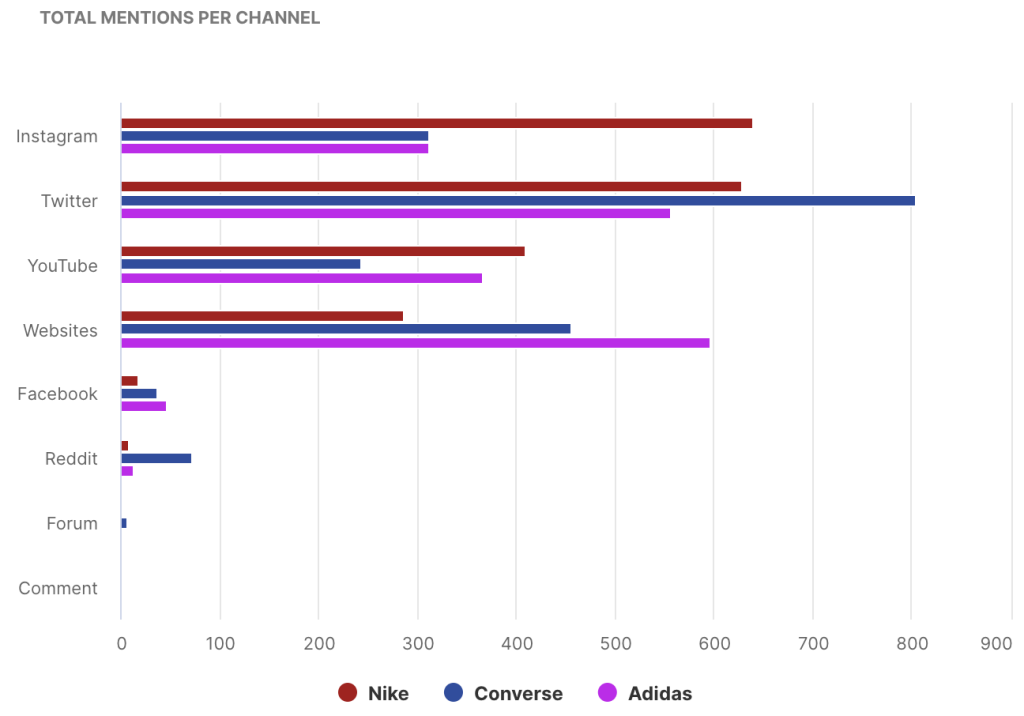
Word cloud
Finally, there is the Word cloud chart. Word cloud shows you the context in which your brand was mentioned. Simply, it displays the words that were mentioned the most alongside your query.

The Word cloud is a great visualization of the things people usually associate with your brand. Therefore, it can be an indicator of the brand reputation in general.
It is also a great source of inspiration for creating content, titles, and campaigns, as it shows you what are people looking for when mentioning your brand.
Read: Discover new information about your brand with Word cloud
The Best Brand Reputation Management Tools
To establish industry go-to’s, we asked PR and communication experts which brand reputation management tools they use and why do they love them.
Here are their responses:
Google Alerts
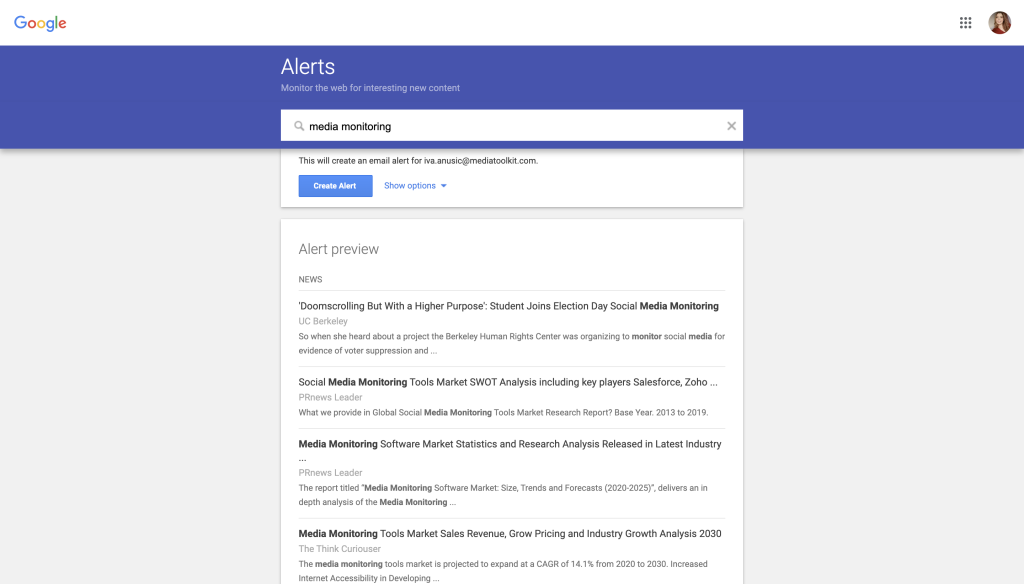
Google Alerts is a great monitoring tool to start with. The main reason for it being, it’s free. Once set up, the service will notify you of every brand mention found on Google’s search engine.
Chris Muktar, the founder of WikiJob.co.uk, prefers Google Alerts “because they’re easy to access. It also sends you notifications through emails depending on how often you want them to.“
Determ
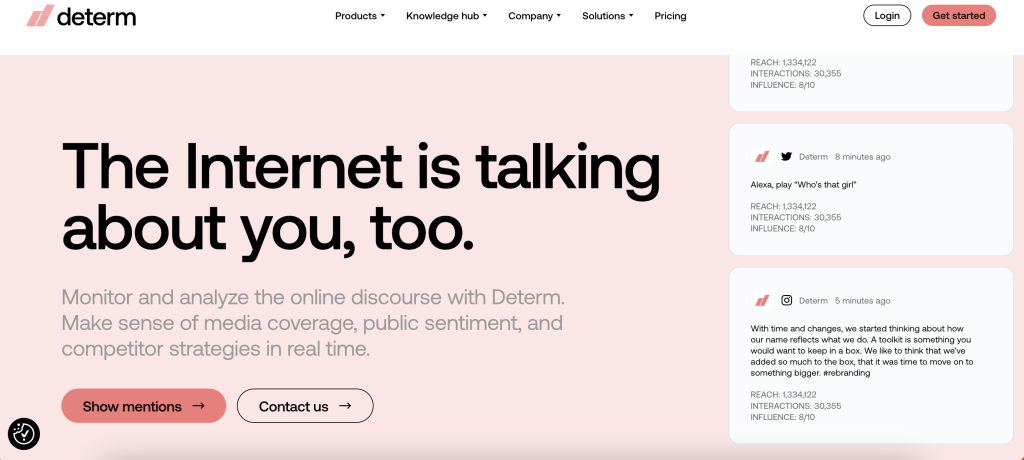
Determ’s advanced features have earned it an award-winning status and trust from businesses across the globe. The number of users, keywords, and media reports is unlimited for all plans, at 25 queries and 50 000 mentions a month.
Romantific‘s Editor Samantha Moss recommends Determ for delivering on its promise of real-time social listening in all languages and locations. “It enables you to understand your brand better and helps you identify which areas you need to improve in.“
Sprout Social
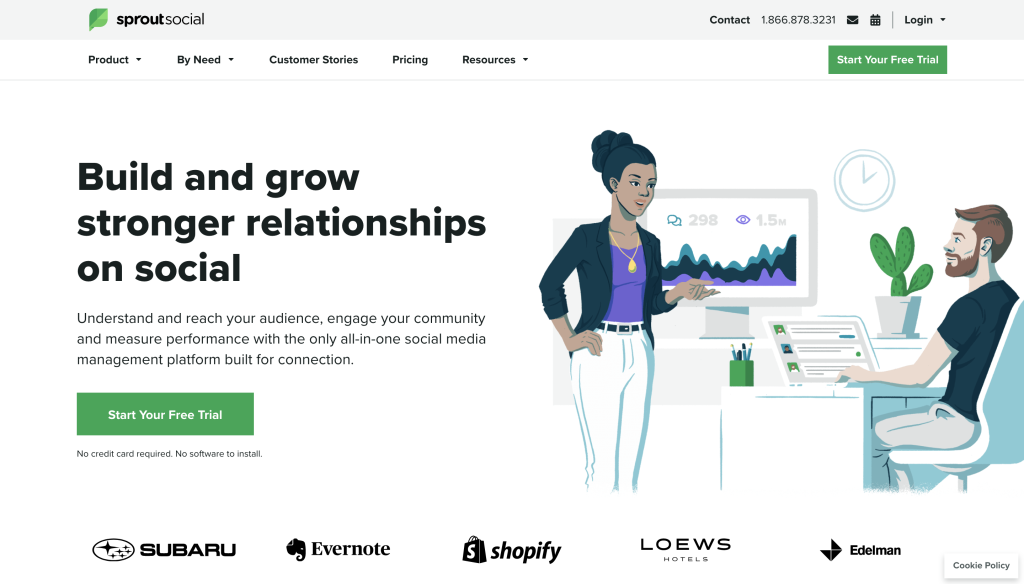
Sprout Social is a social media management solution that encompasses audience insight and community management. They have 3 pricing plans available, with the Standard one starting with 5 social profiles.
Johan Hajji, the CEO and founder of UpperKey, likes Sprout Social because “it’s a kind of two in one deal whereby you get sentiment analysis tools and, also, social media scheduling and publishing tools. This is quite important for us as it saves us time and money – which is a big deal for many of us in 2020.“
Brand24
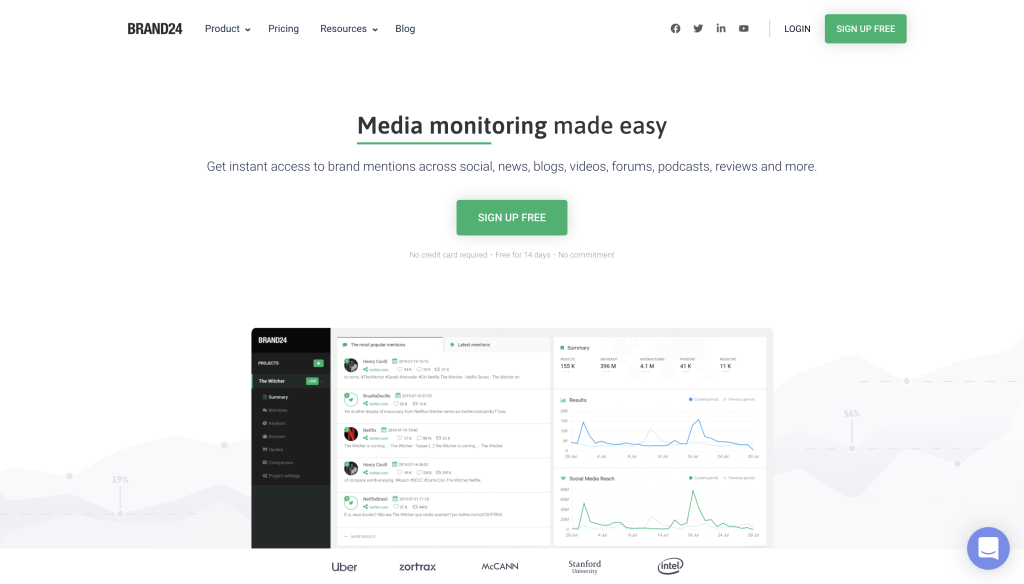
Brand24 is a media monitoring tool with features that comprise monitoring insights and marketing analytics. They offer 4 pricing plans – Individual, Team, Pro and Enterprise, with Individual starting at 3 keywords and 2K mentions a month.
Kylee Jacobs, Chief Marketing Officer at The Absolute Dater, recommends it since it’s user-friendly. “By just simply inputting keywords or hashtags, you can easily see how your brand made an impact.“
BuzzSumo
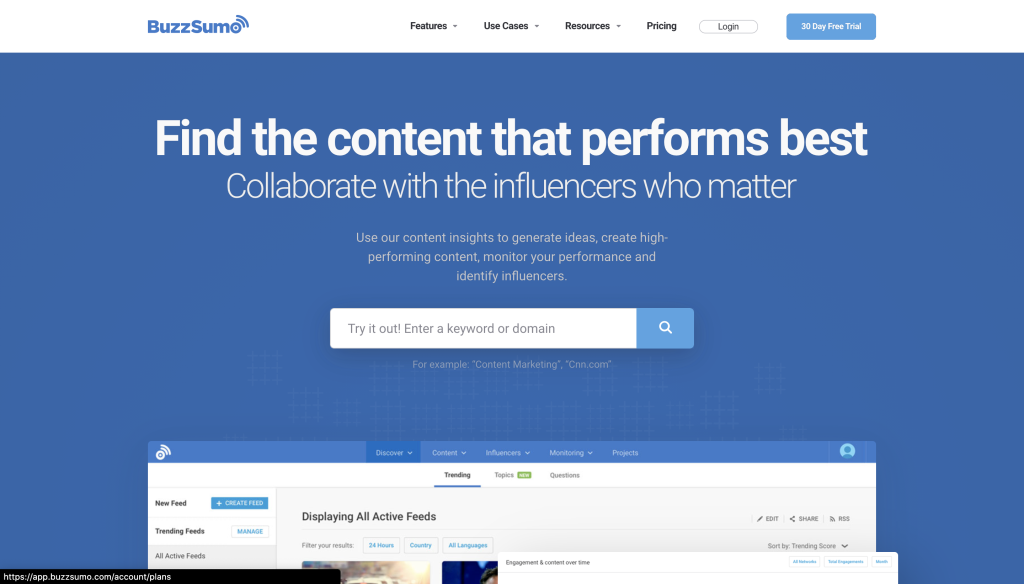
BuzzSumo is a content-focused platform. You can use it to find trending content and influencers, as well as to measure their performance. They have a free option with 10 searches a month, and there are 3 paid plans available, which all have unlimited monthly searches.
As Carifly Capital‘s Marketing Manager Kimberly Smith explains, “BuzzSumo is a great tool for brand reputation monitoring. You can set up brand alerts to see whenever your company is mentioned online. In my experience, it’s exceeded Google Alerts in function as far as being able to track brand mentions in a timely manner.“
Summarizing Brand Reputation
As Elizabeth Arden perfectly summed it up, “repetition makes reputation, and reputation makes customers“.
Continuously investing in your brand reputation will result in more loyal customers and increased brand support. Customer satisfaction attracts new prospects and ensures repeated purchases and a reliable long-term revenue stream.
Media monitoring tools can be of great help for brand reputation management. Use them to monitor and analyze brand mentions and thus define actionable steps for strategy optimization. This will provide a great boost to your brand reputation strategy.
Don’t forget to utilize expert tips, such as making the most of your brand image, being transparent, and willing to promptly respond to any feedback. Do you have any additional tips on brand reputation management? Leave them in a comment below and share this article if you found it helpful!



